The Fight Against Emerald Ash Borer
Michigan leads the way in protecting ash trees, by introducing parasitic Asian wasp.
![Emerald ash borer larva in ash tree. Photo by Pennsylvania Department of Conservation and Natural Resource [CC BY 3.0 (http://creativecommons.org/licenses/by/3.0)], via Wikimedia Commons.](https://urbanmilwaukee.com/wp-content/uploads/2016/07/Eablarva.jpg)
Emerald ash borer larva in ash tree. Photo by Pennsylvania Department of Conservation and Natural Resource [CC BY 3.0 (http://creativecommons.org/licenses/by/3.0)], via Wikimedia Commons.
Now they say hundreds of millions, according to Deb McCullough, a professor in Michigan State University’s entomology and forestry departments. Still, there’s hope for the ash’s survival.
“In a nutshell, what I found is that [ash] seems to be holding on quite well,” said Dan Kashian, who studies ash tree regeneration.
The mortality varies among species, but now the devastation has become an international epidemic, and a scourge in Wisconsin.
The culprit is the emerald ash borer, Agrilus planipennis Fairmaire, an exotic Asian beetle discovered in southeastern Michigan near Detroit in the summer of 2002. Adult beetles are metallic green and about 1/2-inch long. They hitched rides on ship and plane cargo originating from Asia and moving to Detroit.
Wisconsin has an estimated 700 million ash trees and the ash borer has been found in more than 40 counties, including almost the entire southern half of the state. Quarantines are in effect in these counties, including Milwaukee, to prevent the disease spreading, meaning you are not allowed to use or transport the wood or any part of the tree.
In Milwaukee, 24 percent of the canopy — 356,000 trees — in the 15,000 acres of county parks are ash trees. Nearly 3,000 trees have been removed from the parks since 2009 due to emerald ash borer.
But it all started in Michigan. “The longest history of the emerald ash borer in North America is right in the greater metro Detroit area,” McCullough noted. It’s hard to find a lot of live ash trees in Lower Michigan and much of the eastern and central Upper Peninsula.
Kashian, an associate professor at Wayne State University, found himself in this prime location for assessing the plight of the ash.
“It’s been here longer than it’s been anywhere else, so it’s a good place to study what it’s going to look like, say, in Traverse City in 15 years,” he said.
The three main ash species in Michigan are green, white and black ash. They grow in very different places, according to Kashian: black ash in swamps, green ash near rivers and white ash in the uplands.
Kashian is studying how the different species respond to the ash borer. So far, his team has only set up seed traps and other regeneration trackers in 17 pockets in southeastern Michigan that are almost entirely green ash.
For five years, the study quantified how many seeds fell and how many new seedlings took root.
“It looks awful because the big trees are all being killed, and in terms of it ever looking like it did before the emerald ash borer came through, it’s probably never going to happen,” Kashian said. “But the species does not – at least based on what I’ve seen – look like it’s going to disappear, which is what a lot of people were predicting.”
MSU and other leading agricultural researchers, as well as government and non-profit institutions, have created and now support the Emerald Ash Borer Information Network, a multinational effort to share the latest information about the emerald ash borer as it spreads.
The network reports that the insect is established in Windsor, Ontario, was found in Ohio in 2003, northern Indiana in 2004, northern Illinois and Maryland in 2006, western Pennsylvania and West Virginia in 2007, Wisconsin, Missouri and Virginia in the summer of 2008, Minnesota, New York, Kentucky in the spring of 2009, Iowa in the spring of 2010, Tennessee in the summer of 2010, Connecticut, Kansas, and Massachusetts in the summer of 2012, New Hampshire in the spring of 2013, North Carolina and Georgia in the summer of 2013, Colorado in the fall of 2013, New Jersey in the spring of 2014, Arkansas in the summer of 2014, Louisiana in the winter of 2015.
Kashian said he wouldn’t go as far as to say the ash and the borer have reached an equilibrium.
“But we seem to be approaching some kind of balance with the bug at this population level and the trees hanging on,” he said.
The prevailing story of other studies is that the borer will eliminate ash in Michigan as it spreads. That’s because the studies were done in mixed forests where green ash were dying and different trees grew into the space, said Kashian.
In the pure stands of ash that Kashian studied, the dying green ash only made way for new ash seedlings.
“It’s very dependent on how much ash is there,” he said. “I think the more ash that’s there, the more likely it is to survive. A lot of people think intuitively the opposite – the conventional wisdom is that if it’s a pure stand, the bugs will just go crazy and kill everything.”
In northern Michigan, big stands of white ash are a concern. Though Kashian’s team hasn’t studied white ash yet, he suspects a similar phenomenon in which the trees growing in mixed forests won’t fare as well as those in pure stands.
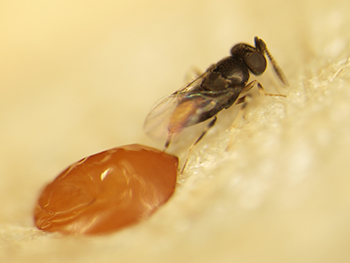
A parasitic wasp injects its egg in the egg of an emerald ash borer where it will hatch, grow and kill the host egg. Photo by Jian Duan.
While it’s still early to tell, Kashian said there is some indication that where parasitic wasps were released to control the ashborers, larger ashes survived and more of them regenerated.
It might not be ideal to release a nonnative species, he said, but if we want to maintain nice, big ash trees, it’s something we need to do.
“The most well-funded programs aren’t even talking about stopping the emerald ash borer, they’re talking about slowing it,” Kashian said. “Whether or not (bio control) is cheap is kind of a moot point because there’s not really any other choice.”
For the eight-plus billion ash trees in the forest in the U.S., it’s hard to justify treating with an insecticide, McCullough said.
“It’s just not economically or environmentally appropriate,” she said. “That means you have to look for other options, and right now we don’t have much else other than bio control.”
The Emerald Ash Borer Biological Control Production Facility in Brighton, Michigan, rears Asian wasps that fight the borer.
“We work with the federal entities and the state entities to identify infested sites within each individual state,” said Ben Slager, the manager of the lab facility.
The borer has now been identified in 27 states, and the lab has three more to distribute to: Georgia, Texas and Nebraska, Slager said. The tiny, wasp-like parasitoids were first released in Michigan in 2007, and have been released in all eight of the Great Lakes states.
“One of the goals for our agency is to get parasitoids into every infested county,” he said. “Last year, (the lab) put out 1.2 million, the year before that it was 750,000 and we’ve been steadily increasing through the years.”
The Bio Control Production Facility releases three different species of the wasps and is in the process of introducing a fourth. Its production of the fourth species has been ongoing since last fall, Slager said, but while they are doing scheduled releases this season, it’s only on a limited basis since they are still getting their rearing methods and procedures down.
The benefit of the new species is that it can lay eggs in trees with thicker bark because it has a longer ovipositor.
A version of this story was originally published by Great Lakes Echo.
Great Lakes Echo
-
Tracking Balloon Debris in Great Lakes
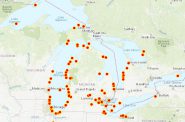 Dec 3rd, 2019 by Tasia Bass Cont
Dec 3rd, 2019 by Tasia Bass Cont
-
Coal Ash Pollutes Midwest States
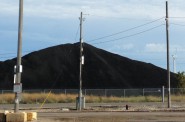 Jun 5th, 2019 by Andrew Blok
Jun 5th, 2019 by Andrew Blok
-
Extreme Changes Forecast for Great Lakes
 May 21st, 2019 by Cassidy Hough
May 21st, 2019 by Cassidy Hough

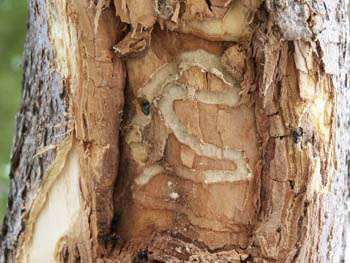
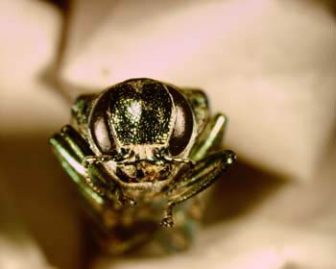
















We’re in Ozaukee County and it’s very real up here. On our block alone the village took down about 20 trees. A real shame.
Great reporting on a very important issue! The ash blight will have many long-term effects beyond just managing the ash population. As the tree canopy is decimated, it has implications for public health, global warming and the look and feel of once-heavily treed places. Some areas, including in Metro Milwaukee, have never fully rebounded from massive losses to Dutch elm disease. Our canopy is still way below those levels.
Loss of tree canopy must be addressed as much on private property as on public land (along streets and in parks). Greening Milwaukee warns that people are NOT replanting shade trees on private property in sufficient numbers to maintain even modest canopy percentages (the current trend is to install “lifestyle” amenities to create shade instead).
Biodiversity calls for planting many different species of canopy trees to help avert future wipe-outs of monocultures (even native ones like ash). Some public agencies are finally catching on and changing policies.
WUWM reported last year that Milwaukee city and county, and Ozaukee County, are all addressing the ash borer very differently, based on roles ash trees play and their locations.
http://wuwm.com/post/milwaukee-area-communities-deal-emerald-ash-borer-different-ways#stream/0
Since nearly a fourth of Milwaukee County parks are ash trees and many of them are expected to die, our parks and parkways may soon look very different, at least for a while. And citizens will need to sound off to make sure fallen street trees are replanted.